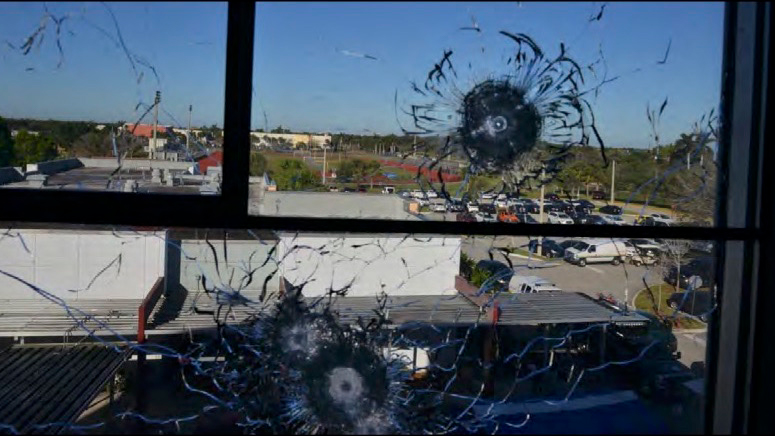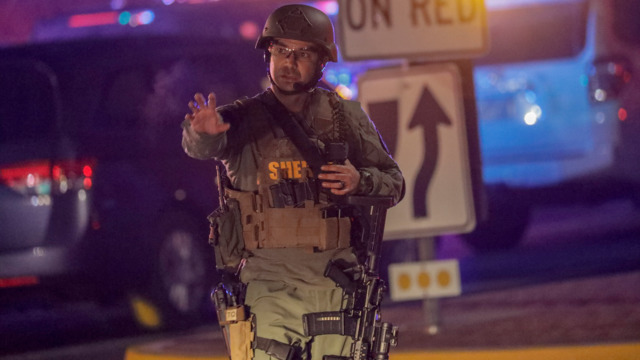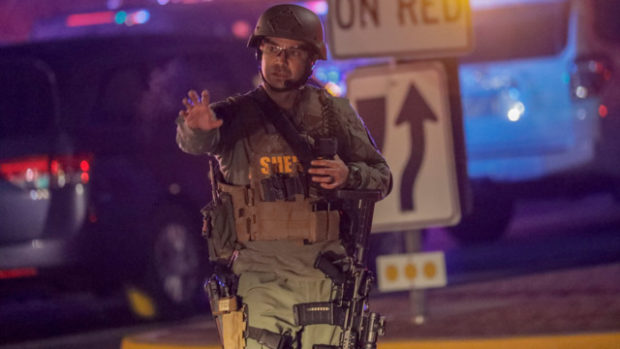Written by: Greg Ellifritz
Cops have dramatically changed the way they handle active killer attacks in the last two decades. It may be time for yet another fundamental change in police response tactics.
I was reviewing some of the recent articles about the Borderland Bar shooting in California. During that shooting, the killer purposely stopped firing on the victims to set up an ambush to attack the police officers he knew were coming. That’s a relatively rare event and it’s one our current police response procedure isn’t likely to effectively counter.
Read about what happened in the article below:
Borderline Gunman Used Smoke Grenades to Create Chaos, Waited to Ambush Police
“Long had a flashlight with a laser sight attached to his handgun, and he threw multiple smoke grenades into the bar to create chaos and confusion inside, Ayub said.
After the initial shooting, he positioned himself in anticipation of the police response, Ayub said. When officers entered, he ambushed them immediately from a position of tactical advantage. The officers returned fire but did not strike him, and then retreated from the scene and waited for SWAT and other negotiating experts,”
Quite honestly, it’s exceedingly difficult for a single officer or pair of officers to defend against a well-designed ambush. When the suspect stops shooting innocent victims and takes a position hidden behind cover in the haze and confusion of a smoke-filled and chaotic crime scene, he’s probably going to get the drop on the first couple of officers who go in after him.
It’s a sad reality.
Should we alter our response tactics to deal with ambushing active killers? Maybe. Maybe not.
Before we address that topic, a short history lesson is in order. We have to understand how and why we utilize our current tactics before we start deviating from them.
Before Columbine (in 1999), police response was to surround the building and wait for SWAT officers to make entry. After seeing that fail so miserably at Columbine, the leading thinkers of the day decided that we had to empower patrol officers without much tactical experience to quickly make entry to active shooter scenes and end the violence.
Tactical trainers took a look at the characteristics of the Columbine attack. There were multiple shooters. They had more than 100 explosive devices. They set explosive booby traps. They were prepared to ambush any officers who made entry.
How do you train patrol officers to deal with that mess?
You make entry as a team where you have enough manpower to simultaneously have 360-degree visual coverage and the ability to split the team to handle explosive devices and multiple shooters.
Thus the “posse concept” was formed. Officers were taught to meet up at a predetermined location and made entry as a team of between four and six officers. Police departments embraced the concept and trained in “quad” or “tactical diamond” formations.
It was a good idea, but in hindsight we were in essence preparing for “the last war,” not the most likely threat.
We didn’t see another ambush style active killer attack until the DC Navy Yard Shooting in 2013. We didn’t see another multiple attacker active killer event until the police assassination and subsequent WalMart shooting that happened in Las Vegas in 2014.
Those worst case scenario situations we were training to overcome just weren’t happening.
Studying active killer events during most of the 21st century showed us that the killer would be alone and he would be too busy racking up a large body count to set up ambushes for responding officers. The attacks also weren’t lasting as long as the Columbine siege, with 69% of active killer attacks completed in five minutes or less.
It turned out that our “posse formations” simply took to long to organize. By the time cops rounded up four to six officers to make entry, the attack was finished. Our group entries weren’t saving lives, they were causing more deaths.
With very few exceptions, active killers were shooting between four and eight victims per minute during their rampages. Some outlier events like the recent Las Vegas concert shooting demonstrated even faster rates of fire (538 people injured in 10 minutes).
It’s relatively simple math. Most urban or suburban police departments can get one officer on the scene of an active killer attack in three to four minutes. Many can get two officers there in five minutes. For most agencies, getting four officers on scene takes about 10 minutes from the time the officers are dispatched.
The difference between a single officer response and a four-officer team response is about six minutes in time. In waiting those extra six minutes, an average of 48 more victims will be shot. That’s unacceptable.
Around the year 2005, progressive police trainers (led by Ron Borsch and the Tactical Defense Institute) began advocating single officer entries for most active killer attacks. These trainers recognized very early that the average active killer attack was of very short duration and involved a single, mentally deranged shooter who was not setting up ambushes. That honestly isn’t a very difficult problem to solve. A single well-trained officer can make immediate entry, take the shooter out, and save dozens of lives.
Departments slowly started transitioning to teaching solo officer response. I first trained my police department in single officer response tactics starting in 2008. It’s taken nearly a decade of work, but now solo officer responses have become standard practice for most well-trained police agencies.
Fast forward to today.
Active killers now know that the first cop on the scene is coming in with guns blazing as soon as he rolls up. The killer knows that he only has three to four minutes to inflict his carnage before the cops show up and spoil the party. Just like we’ve modified our tactics to respond to changes in killing patterns, the killers are beginning to modify their tactics to prolong the amount of time they have to kill more innocent victims.
Now the killers are planning to either escape the scene in the first few minutes or they are setting up ambushes to take out the first couple officers on scene (as seen in the Borderland shooting).
We are starting to see a slight increase in multiple attacker active killer events (Las Vegas and San Bernardino). We are also seeing worldwide symphonic terrorist attacks involving multiple suspects. Take a look at the Beslan school hostage siege, the Australian Lindt cafe hostage siege, the Bangladesh restaurant hostage siege, and the Nord Ost theater attack. The French Bataclan Theater hostage incident fits that profile as well.
Multiple killers and teams of trained terrorists may require more than a single patrol officer to be resolved.
In addition to multiple attackers, we are seeing killers attempting to ambush cops as they make entry. Besides the California bar shooting I mentioned earlier, we have the DC Navy Yard shooting, the Las Vegas incident, and the Kirkersville, Ohio police chief assassination. The Pulse Nightclub Shooting might have also involved an ambush of the initial responding officers.
In response to these more complex threats, do we need to revert back to an approach involving containment and SWAT notification? Do we need to revert back into teaching multiple officer entries?
I don’t think either of these ancient solutions will effectively solve our modern problems.
Most active killers are still alone and distracted. If we waited for SWAT for all of those, too many people would be killed.
What about going back to multiple officer entries? Would that help responding officers better overcome a killer’s ambush?
Maybe, but not likely. Remember that in the most recent California bar shooting ambush, two officers made entry together. The second officer not only wasn’t able to defeat the ambush, his “friendly fire” killed his partner. All he could do was to fire a few rounds and then drag out his colleague’s dead body. Multiple cops making entry into the same ambushed position just gets more cops shot.
So what can we do?
Our tactics need to continually improve and adapt. I would still recommend single officer entry as a primary response strategy, but I would modify the solo officer and subsequent response in the following manner:
Multiple near simultaneous entries. Current tactical doctrine dictates that if officers arrive at the location of the attack at the same time that they make entry together. I think this is a mistake. Officers should make entry independently via different entry points. Each further arriving officer should make entry from a different door if possible.
Sending multiple cops on a hunting mission from different angles and entry points makes it very hard for the killer to ambush everyone. It also makes it far more difficult for the killer to escape. Whenever I’ve played the role of “bad guy” when multiple independent cops are each seeking me from a different direction, I’ve been completely tactically overwhelmed. When cops do this, the bad guy quickly goes on the defensive, saving the lives of both police officers and innocent victims.
We should be training our cops to make entry from different positions as they arrive on scene.
This strategy may increase the risk of “blue on blue” shootings, but will reduce the chance for all of the officers to be killed in the same ambush attack. It may also negate some of the advantages that multiple attackers possess.
Making entry from a location that cannot be hit when the killer shoots from inside the building. It’s relatively rare, but we have seen active killers attempt to ambush responding cops by shooting at them from inside the building while the cops make their approach.
During this year’s Parkland School Shooting, the killer fired at either fleeing students or approaching police officers from an elevated window in the teacher’s lounge. The only thing that saved his targets was the fact that the Florida building code required hurricane resistant glass windows. The heavy duty windows partially deflected some of the killer’s shots.

Bullet holes in the window of the Parkland teacher’s lounge where the killer fired upon fleeing students and responding officers.
If you have an option about where you can make entry, choose a location that cannot be observed from elevated windows.
Distractions like smoke and flashbangs for entry. If officers are forced to make entrance via a predictable route, they should cover their entrance with either smoke or by using flash/bang grenades. Both SWAT cops and the military use these tactics with some regularity when they have to assault defended positions. Right now, most patrol cops don’t carry either smoke grenades or bangs. That needs to change if we expect those cops to make a solo response to a potential ambush.
Creating our own entrance points. More importantly, we need to teach cops to think outside of the box. If the entrances are ambushed, we need to make entry at another location. We need to teach cops how to drive cars and SUVs through walls. We need to teach cops how to breach windows and make entry from those points of access. We need to equip cruisers with ladders, “break-and rake” tools, and other hardware that cops can use to make their own holes for entry.
We should also consider sending more patrol officers to explosive breaching schools and teaching them how to quickly blow holes through walls. I don’t know any current police departments who train their patrol officers as explosive breachers. Just like using flashbangs, explosive technology is relegated to the SWAT cops. That has to change if we want to keep up with the threats we face.
I recognize it’s going to be hard for most cops to sell these changes to their administrations. We still have to try.
In 1999, we couldn’t imagine patrol officers responding to situations traditionally handled by SWAT operators. In 2005, we couldn’t imagine sending a single officer in to stop an active killer. Both are now commonplace and best practices throughout the industry.
In the next decade, you will see my recommendations in this article become commonplace as well. Does your agency want to be ahead of the adoption curve or behind it?



